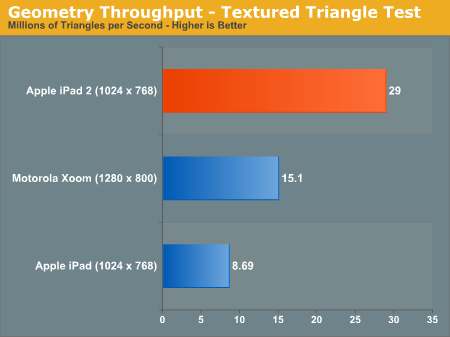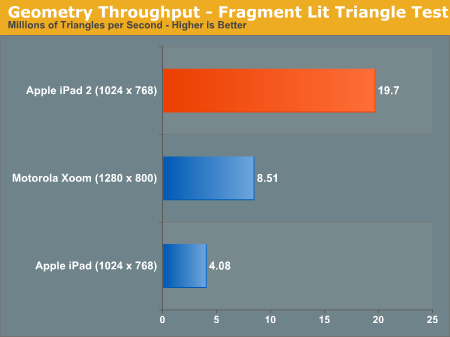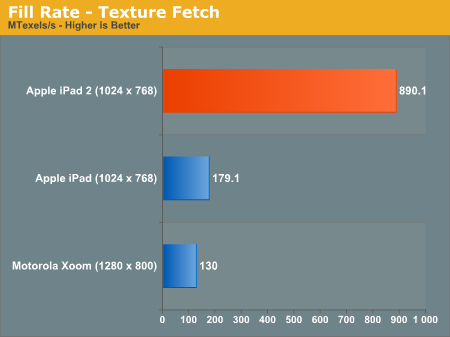Apple iPad 2 GPU Performance Explored: PowerVR SGX543MP2 Benchmarked
by Anand Lal Shimpi on March 12, 2011 3:04 PM EST- Posted in
- Smartphones
- Apple
- iPad
- GLBenchmark
- iPad 2
- Mobile
- Tablets
Earlier this morning we published our first impressions on Apple's iPad 2, including analysis on camera quality and a dive into the architecture behind Apple's A5 SoC. Our SoC investigation mostly focused on CPU performance, which we found to be a healthy 50% faster than the A4 in the original iPad - at least in web browsing. We were able to exceed Apple's claim of up to 2x performance increase in some synthetic tests, but even a 50% increase in javascript and web page loading performance isn't anything to be upset about. We briefly touched on the GPU: Imagination Technologies' PowerVR SGX 543MP2. Here Apple is promising up to a 9x increase in performance, but it's something we wanted to investigate.
Architecturally the 543MP2 has more than twice the compute horsepower of the SGX 535 used in Apple's A4. Each shader pipeline can execute twice the number of instructions per clock as the SGX 535, and then there are four times as many pipes in an SGX 543MP2 as there are in a 535. There are also efficiency improvements as well. Hidden surface removal works at twice the rate in the 543MP2 as it did in the 535. There's also a big boost in texture filtering performance as you'll see below.
As always we turn to GLBenchmark 2.0, a benchmark crafted by a bunch of developers who either have or had experience doing development work for some of the big dev houses in the industry. We'll start with some of the synthetics.
Over the course of PC gaming evolution we noticed a significant increase in geometry complexity. We'll likely see a similar evolution with games in the ultra mobile space, and as a result this next round of ultra mobile GPUs will seriously ramp up geometry performance.
Here we look at two different geometry tests amounting to the (almost) best and worst case triangle throughput measured by GLBenchmark 2.0. First we have the best case scenario - a textured triangle:

The original iPad could manage 8.7 million triangles per second in this test. The iPad 2? 29 million. An increase of over 3x. Developers with existing titles on the iPad could conceivably triple geometry complexity with no impact on performance on the iPad 2.
Now for the more complex case - a fragment lit triangle test:

The performance gap widens. While the PowerVR SGX 535 in the A4 could barely break 4 million triangles per second in this test, the PowerVR SGX 543MP2 in the A5 manages just under 20 million. There's just no competition here.
I mentioned an improvement in texturing performance earlier. The GLBenchmark texture fetch test puts numbers to that statement:

We're talking about nearly a 5x increase in texture fetch performance. This has to be due to more than an increase in the amount of texturing hardware. An improvement in throughput? Increase in memory bandwidth? It's tough to say without knowing more at this point.
| Apple iPad vs. iPad 2 | ||||
| Apple iPad (PowerVR SGX 535) | Apple iPad 2 (PowerVR SGX 543MP2) | |||
| Array test - uniform array access |
3412.4 kVertex/s
|
3864.0 kVertex/s
|
||
| Branching test - balanced |
2002.2 kShaders/s
|
11412.4 kShaders/s
|
||
| Branching test - fragment weighted |
5784.3 kFragments/s
|
22402.6kFragments/s
|
||
| Branching test - vertex weighted |
3905.9 kVertex/s
|
3870.6 kVertex/s
|
||
| Common test - balanced |
1025.3 kShaders/s
|
4092.5 kShaders/s
|
||
| Common test - fragment weighted |
1603.7 kFragments/s
|
3708.2 kFragments/s
|
||
| Common test - vertex weighted |
1516.6 kVertex/s
|
3714.0 kVertex/s
|
||
| Geometric test - balanced |
1276.2 kShaders/s
|
6238.4 kShaders/s
|
||
| Geometric test - fragment weighted |
2000.6 kFragments/s
|
6382.0 kFragments/s
|
||
| Geometric test - vertex weighted |
1921.5 kVertex/s
|
3780.9 kVertex/s
|
||
| Exponential test - balanced |
2013.2 kShaders/s
|
11758.0 kShaders/s
|
||
| Exponential test - fragment weighted |
3632.3 kFragments/s
|
11151.8 kFragments/s
|
||
| Exponential test - vertex weighted |
3118.1 kVertex/s
|
3634.1 kVertex/s
|
||
| Fill test - texture fetch |
179116.2 kTexels/s
|
890077.6 kTexels/s
|
||
| For loop test - balanced |
1295.1 kShaders/s
|
3719.1 kShaders/s
|
||
| For loop test - fragment weighted |
1777.3 kFragments/s
|
6182.8 kFragments/s
|
||
| For loop test - vertex weighted |
1418.3 kVertex/s
|
3813.5 kVertex/s
|
||
| Triangle test - textured |
8691.5 kTriangles/s
|
29019.9 kTriangles/s
|
||
| Triangle test - textured, fragment lit |
4084.9 kTriangles/s
|
19695.8 kTriangles/s
|
||
| Triangle test - textured, vertex lit |
6912.4 kTriangles/s
|
20907.1 kTriangles/s
|
||
| Triangle test - white |
9621.7 kTriangles/s
|
29771.1 kTriangles/s
|
||
| Trigonometric test - balanced |
1292.6 kShaders/s
|
3249.9 kShaders/s
|
||
| Trigonometric test - fragment weighted |
1103.9 kFragments/s
|
3502.5 kFragments/s
|
||
| Trigonometric test - vertex weighted |
1018.8 kVertex/s
|
3091.7 kVertex/s
|
||
| Swapbuffer Speed |
600
|
599
|
||
Enough with the synthetics - how much of an improvement does all of this yield in the actual GLBenchmark 2.0 game tests? Oh it's big.











219 Comments
View All Comments
rish95 - Saturday, March 12, 2011 - link
I expected nothing less. I knew the SGX543MP2 could beat a Tegra, but never expected a margin like this.tipoo - Saturday, March 12, 2011 - link
My thoughts exactly. I was excited for Tegra 2 devices, but this MP2 beats it handily.vol7ron - Saturday, March 12, 2011 - link
I'm more impressed by the For Loop test. I think that's the biggest testament to the memory/processing improvements.Ringer9 - Saturday, March 12, 2011 - link
"I expected nothing less.... but never expected a margin like this." Are you a politician?Griswold - Sunday, March 13, 2011 - link
He sure sounds like one.nafhan - Saturday, March 12, 2011 - link
Considering how well the SGX540/Hummingbird did compared to the Tegra 2 in GPU bound situations, it's not that surprising. Plus, you've got to imagine that things may be more optimized on Apple's software side of things since they've only got a single GPU to work with (and one that's an evolutionary advancement from the old one, at that). Check out some of the Tegra 2 compared to Hummingbird benches that Anandtech has done in the past.Either way kudos to Apple for pushing the GPU side of things in the mobile space.
Ushio01 - Sunday, March 13, 2011 - link
"Either way kudos to Apple for pushing the GPU side of things in the mobile space."So using an off the shelf part is pushing things now?
Griswold - Sunday, March 13, 2011 - link
Apple invents, revolutionizes and amazes everything and -one.Focher - Monday, March 14, 2011 - link
It's integrated into the A5 SoC, so it's not a "part". And using the best technology is pushing things, because it puts pressure across the competitive landscape to ... compete.designerfx - Sunday, March 13, 2011 - link
Uh, did you forget about the resolution difference?This is like saying "wow! my graphics card runs 120FPS at 640x480 but yours runs it at 34 at 1440x900! My card is superior!"
It's not really better than tegra, the xoom is a horrible product and not at all optimized.
sheesh. Read carefully. Ipad 2 is an improvement, but there are already android phones that run the openGL ES 2.0 test at 45 FPS and that's smartphones, not ipads.